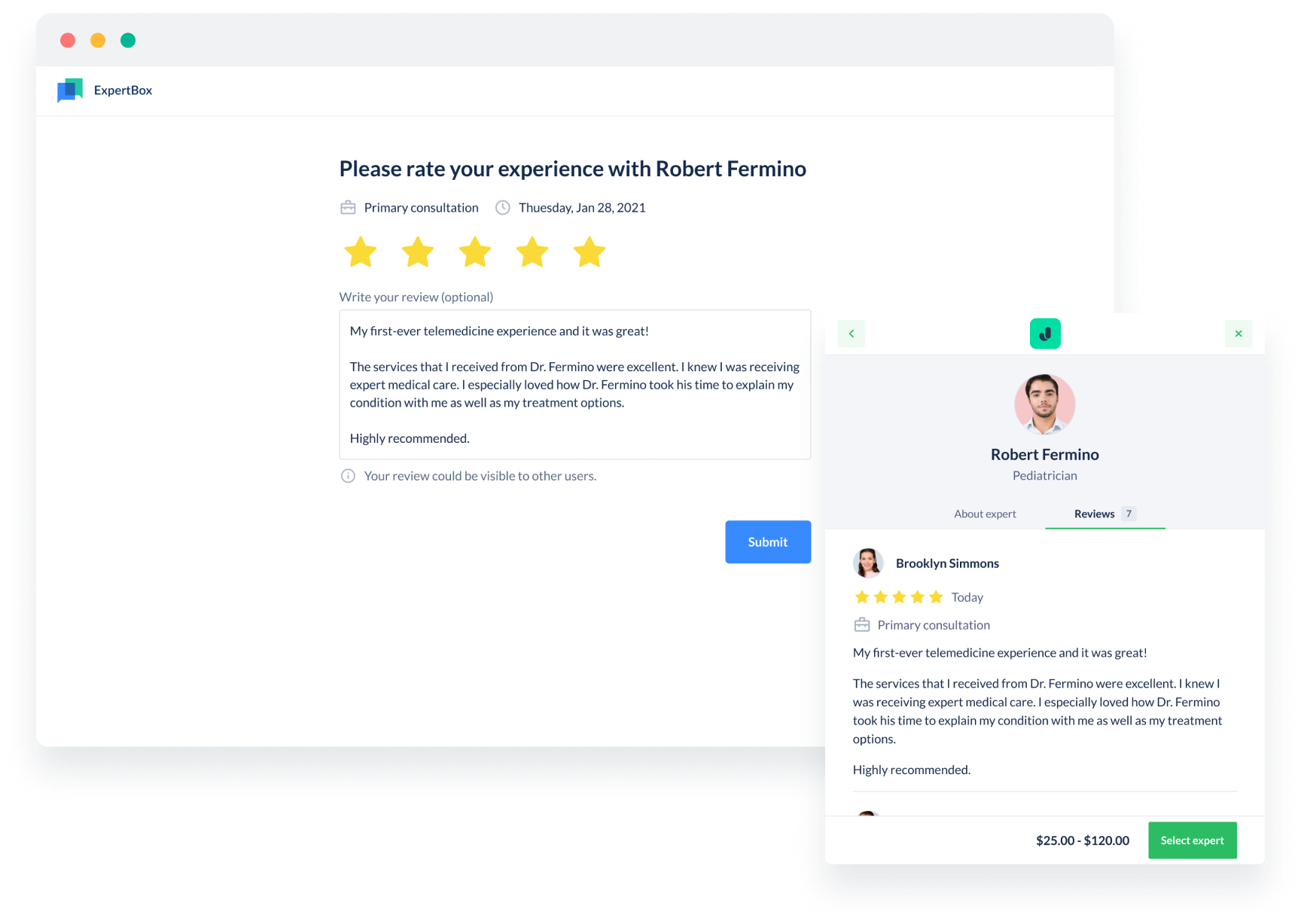Telehealth solutions transform healthcare, making it accessible, cost-effective, and convenient. But what about taking it one step further and setting up your telemedicine practice for lasting success? Learn how to track and measure the performance of your telemedicine program.
Tracking the most important KPIs will give you better insights into your telehealth service’s performance.
In this article, we explore what healthcare KPI metrics can help you evaluate your telemedicine program’s effectiveness and what data points to pay attention to in order to reach your facility’s goals.
Four pillars of a successful telemedicine program
Accessibility of care, the patient experience, medical care quality, and treatment availability are the key pillars of a successful telemedicine program. Let’s see what else drives an efficient telemedicine program and improves your facility’s profits.
Affordability of telemedicine visits versus in-person appointments
There are various types of telemedicine appointments, from consultations regarding an acute sore throat to mental health assessments with a psychiatrist.
Thanks to the affordability of telemedicine services, patients can see physicians at relatively lower costs than regular in-person visits, get medical prescriptions and treatment plans, and be diagnosed without spending time in a physician’s office.

Furthermore, the Centers for Medicare and Medicaid Services have expanded the types of telemedicine services physicians can provide and increased the reimbursement rates for these services.
Healthcare providers’ effectiveness
This measure estimates how a telemedicine program affects physicians’ performance compared to in-office patient appointments.
With the help of HIPAA-compliant video conferencing platforms, remote health monitoring devices, digital patient intake forms, and medical records, healthcare providers can see more patients per day, collect necessary information ahead of the visit, and monitor a patient’s vital signs before the appointment. This leads to improved patient care, a high-quality treatment process, and greater medical practice efficiency.
Patient care outcomes
Telemedicine benefits patients in many ways, including by decreasing wait times and commuting costs. However, the most crucial indicator by which to assess a telemedicine program’s efficiency is the quality of patient health and treatment outcomes.
You can measure those outcomes by estimating the number and frequency of follow-up appointments, the number of patients readmitted after being discharged from a clinic, and the number of accurate diagnoses made during a particular period.
Patient satisfaction
Patient satisfaction is the primary way to determine the efficiency of remote care and whether a healthcare provider has met patient expectations.
You should always collect and analyze patient feedback after an appointment to improve the quality of your telemedicine program. The more patients are satisfied with their telemedicine experience, the higher the chances they’ll become loyal to your practice.
Top healthcare KPI metrics
To help you drive your telemedicine program’s long-term success, we’ve collected key KPI for healthcare providers and split them into three categories for easy navigation.
1. Experience
The experience metrics below show how implementing a telehealth program can improve the patient experience and increase the efficiency of clinic staff.
Patient satisfaction
Patients’ satisfaction with telemedicine services defines whether patients will be eager to return to your facility and recommend it to friends and family.
Digital feedback forms can help you gauge patient satisfaction after an appointment.

Surveys can help you understand the quality of care provided, patients’ concerns, and the most and least profitable virtual care services. As a result, you get data you can rely on when deciding what services to improve and what issues may arise.
Discover how collecting patient feedback can improve the patient experience, increase revenue, and build a positive reputation for your clinic.
Medical staff satisfaction
It’s crucial not only to measure your patients’ satisfaction with virtual care but also your medical staff’s overall satisfaction with their work conditions.
Electronic surveys help you receive feedback and identify how your telemedicine program fulfills your medical staff’s needs and expectations when using telehealth technology.

2. Efficiency
Efficiency metrics reveal whether adopting a telehealth program allows clinics to reduce the rate of no-shows, decrease patient wait times, and increase patient retention.
Patient wait times
Long wait times can damage patient satisfaction with both in-person and virtual care. The longer patients wait for an appointment, the greater the chance they will skip it or choose another healthcare provider.
Electronic patient intake forms help with decreasing patient wait times. Collecting essential patient information before an appointment reduces time spent filling out medical forms during the actual visit. Plus, physicians can learn all necessary details beforehand, dedicating more time to patient care.
Average hospital stay
Tracking the average length of time patients stay in the hospital is a critical healthcare KPI. However, to better understand the situation at the clinic, patients should be divided into groups based on the type of treatment they are receiving. For instance, the duration of stay for a patient undergoing heart surgery is expected to be longer than that of a patient with a wrist sprain. By analyzing the average hospital stay duration of each treatment type, your medical staff can detect any outliers caused by unexpected complications.
No-shows
No-shows can result in revenue loss for the clinic and unresolved health issues for patients. Telemedicine software allows healthcare providers to address patient emergencies and minimize no-shows and last-minute cancellations.

How can healthcare providers reduce the rate of no-shows and increase patient retention?
- Set up automatic appointment reminders when booking and before the appointment. For example, the ExpertBox online booking feature allows patients to book appointments from anywhere without contacting the clinic and receive an appointment reminder at a predetermined time. Patients can also cancel and reschedule their appointments without an administrator’s help, making their experience effortless.
- Allow online payments. Patients can choose the preferred payment method and prepay for their appointment to decrease the possibility of not showing up.
Successful encounters
This metric shows the ratio between the number of scheduled and actual telehealth appointments. By tracking successful encounters, you can evaluate the efficiency of your booking system and scheduling capabilities and the level of patient satisfaction and comfort.

The ExpertBox booking page lets your patients schedule appointments when they want to and at the click of a button. You can create a booking page, integrate it into your website, and customize it according to your preferences to automate the booking process for your patients.
3. Profitability
Profitability metrics demonstrate whether a telehealth program brings the desired profit to your clinic, whether it helps you grow your healthcare business, and whether the costs invested in marketing and equipment pay off.

Patient acquisition cost
Patient acquisition cost (PAC) is the total cost of bringing in a new patient and making that patient choose your healthcare services.
Your patient acquisition cost depends on your marketing expenses and your strategies to attract patients, such as email campaigns, social media promotions, and online ads. Optimizing all communication touchpoints and finding the proper marketing channels are vital to driving more telemedicine appointments, bringing in new patients and lowering customer acquisition expenses.
Cost per visit
This is a critical metric to measure regularly, for example, every month. It shows you the actual expenses you spend on every patient per appointment and helps you understand how effective your telehealth program is.
To estimate your Cost per visit, you should calculate the total costs, including medical employees' salaries, equipment, and other supplies, insurance, and technology systems.

Profit per month
By calculating your monthly profit, you understand how much your clinic earns or losses during that month. It's crucial to monitor since the metric determines the telehealth program's profitability in the long term and shows you what to improve in healthcare delivery to gain higher revenue.
Here's how to calculate:

By using all-in-one clinic management software such as ExpertBox, your medical staff can reduce administrative work and treat more patients, increasing the overall clinic's revenue.
Revenue per visit
This metric shows actual income a clinic receives from each appointment, excluding all direct costs associated with it. Did it change for your clinic since you’ve implemented telehealth? You can measure it using the following formula:

Tracking this indicator will help you determine the reasons of profit decrease over the chosen period. Thus, you can pay attention to areas that have a negative impact on clinic revenue.
Hardware, software, and other cost items
To perfectly plan your telemedicine budget, estimate your telehealth cost items.
- Hardware costs for equipment to support virtual appointments, such as computers, tablets, and cameras
- Costs for installed software and software subscriptions
- Medical staff-related expenses such as for training, marketing, and providing technical support to patients
Furthermore, you may need to upgrade technology and regularly pay fees.
You can choose all-in-one software that requires relatively few investments and will help you achieve a high ROI. ExpertBox is a secure solution that’s optimal in terms of functionality and price.

Equipment utilization rate
Your clinic should invest in the right telehealth equipment for effective patient care. To provide virtual appointments, you may need the following tools:
- Telehealth software
- Telemedicine carts
- Wireless scales
- Virtual otoscopes and stethoscopes
- Wearable monitors
- And more
You should regularly maintain your telehealth equipment and make sure it runs properly.
Insufficient preventive measures for telehealth equipment may result in poor standards of patient diagnoses and increase the cost of equipment maintenance.
Insurance claim processing time
Monitoring the time of processing insurance claims is essential for adequate cash flow. Different insurers can take varying amounts of time to issue payment, so tracking this metric is vital to ensure timely payment and the financial stability of your facility.
Overall reimbursement
Define what types of telemedicine services you provide to know how you’ll get reimbursed and how to bill your patients.
In the US, individual states have exceptions and restrictions on what solutions can and cannot be reimbursed. Compared to real-time telehealth services, store and forward (asynchronous) telehealth services are commonly less reimbursed by Medicare and Medicaid.
Federal law also restricts Medicare’s telehealth coverage of asynchronous telehealth to specific projects in Alaska and Hawaii.
Furthermore, private insurance companies are increasing telehealth coverage. Check the coverage with each insurance provider, as every company’s telehealth policy is different.
Telemedicine software to achieve feasible results
There’s no one-size-fits-all approach to successfully providing telemedicine. Gaining the best possible outcomes requires robust preparation, precise goal-setting, and constant tracking and adjustments. Setting goals will give you a clear picture of what a telemedicine program should look like for your patients, healthcare providers, and clinical staff.
You can do this easily with comprehensive clinic management software in place.
Clinic management software is the foundation for your telemedicine program's success. Request a free demo with one of our experts to see what benefits ExpertBox has to offer.
FAQ
-
To drive your telemedicine program’s long-term success, you should track these key performance indicators:
- Medical staff satisfaction
- Patient satisfaction
- Connectivity quality
- Patient wait times
- No-shows/canceled appointments
- Successful encounters
- Patient acquisition cost
- Revenue per visit
- Hardware and software costs
- Overall reimbursement
-
Let’s see what drives an efficient telemedicine program and improves your facility’s profits:
- Affordability of telemedicine visits versus in-person appointments
- Healthcare providers’ effectiveness
- Patient care outcomes
- Patient satisfaction
-
- Set up automatic appointment reminders when booking and before the appointment.
- Allow online payments. Patients can choose the preferred payment method and prepay for their appointment to decrease the possibility of not showing up.



